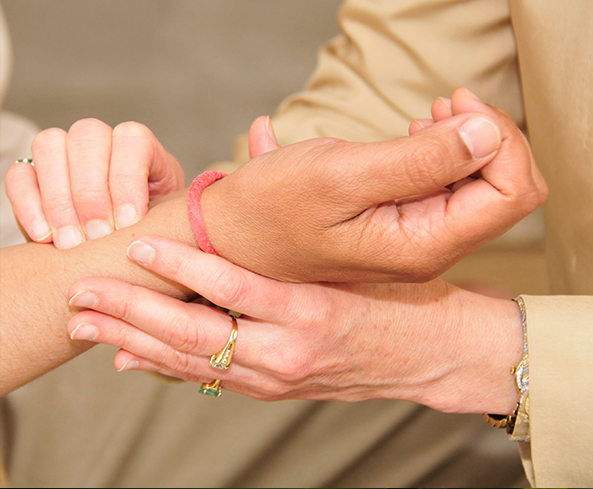AyurVedic Medicine:
Ancient Insights Into Modern Health Care
by Stuart Rothenberg, MD

AyurVeda, the traditional medical system of India, is the world’s oldest system of natural medicine and the original mind-body science. There is currently an upsurge of interest in AyurVedic medicine in the North America, both among health professionals and the general public. AyurVeda offers an extensive, individualized approach to prevention of disease not typically found in conventional medicine. In addition, AyurVeda has a holistic approach to treatment of chronic disease that includes mind, body, behavior, and environment. AyurVeda also includes a classical system of pulse diagnosis that can be readily learned and applied in a contemporary setting.
The word AyurVeda comes from two Sanskrit roots: Ayus, meaning life or life span, and Veda, meaning knowledge or science. AyurVeda is therefore translated as “the science of life,” which emphasizes its orientation toward prevention. The major textbooks of AyurVeda, the Charaka Samhita and Sushruta Samhita, cover the major branches of medicine under much the same headings as conventional allopathic medicine, though with a preventive and holistic orientation. The Ayurvedic pharmacopeia includes thousands of plants and plant products, many of which are now familiar therapeutic agents, such as rauwolfia and digitalis.
Unfortunately, over centuries of colonial rule in India when Ayurvedic institutions were not officially supported, and were even actively suppressed, much important clinical and theoretical knowledge became lost or unavailable. As a result, AyurVeda’s effectiveness became limited, as practitioners did not have access to the full range of its comprehensive approaches. A modern revival of AyurVeda, taking into account all of these approaches in accordance with the classical texts, is known as Maharishi Integrative AyurVeda℠. This restoration has taken place under the direction of Maharishi Mahesh Yogi in collaboration with leading Ayurvedic physicians and scholars.

The Ayurvedic Framework
 Maharishi Integrative AyurVeda emphasizes host factors, particularly imbalances resulting from disruption of intrinsic self-repair and immune mechanisms, as the primary factor in the etiology of disease. The Ayurvedic paradigm is thus reminiscent of Louis Pasteur’s famous statement that “the invader is nothing, the terrain everything.” AyurVeda holds that underlying the functioning of the host’s innate homeostatic and “self-healing” mechanisms is an unmanifest (non-physical) field of biological intelligence, the body’s “inner intelligence” (Atma). AyurVeda places central importance on enlivening this most fundamental level of intelligence in order to promote health and healing from within. It prescribes a variety of modalities, including mind-body approaches, to accomplish this goal.
Maharishi Integrative AyurVeda emphasizes host factors, particularly imbalances resulting from disruption of intrinsic self-repair and immune mechanisms, as the primary factor in the etiology of disease. The Ayurvedic paradigm is thus reminiscent of Louis Pasteur’s famous statement that “the invader is nothing, the terrain everything.” AyurVeda holds that underlying the functioning of the host’s innate homeostatic and “self-healing” mechanisms is an unmanifest (non-physical) field of biological intelligence, the body’s “inner intelligence” (Atma). AyurVeda places central importance on enlivening this most fundamental level of intelligence in order to promote health and healing from within. It prescribes a variety of modalities, including mind-body approaches, to accomplish this goal.
The principle of biologic individuality is central to Ayurvedic diagnosis and treatment. In examining a patient, the practitioner trained in Maharishi Integrative AyurVeda takes into account the particular pathology, but also the constellation of unique psychophysiological characteristics that constitute the individual. Thus in AyurVeda, assessment begins with diagnosis of the individual’s constitutional type or “mind-body type,” which is the starting point for developing an effective prevention or treatment program. In this, AyurVeda presages the trend toward “personalized medicine” now emerging within conventional allopathic medicine. The principle is that foods, medicinals, behaviors, and lifestyle that may be therapeutic for one individual will be different from those that will be therapeutic for another individual, depending upon the individual’s psychophysiological make-up or constitutional type.
According to AyurVeda, three irreducible physiological principles called Doshas regulate the different functions of mind and body. These three fundamental physiological “operators” are understood as the three basic modes of expression of the underlying field of intelligence. In Sanskrit, the three doshas are called Vata, Pitta, and Kapha. Health depends upon achieving a state of functional balance of these three operators. Everyone is endowed at birth with some value of all three doshas, but in each person the exact proportions vary. This proportion determines the psychophysiological type. There are ten classic types, derived from the combinations of the three doshas.
The three doshas are further subdivided into numerous subdoshas with different locations and functions throughout the body. Imbalance in the doshas and subdoshas disrupts normal function and is responsible for various disorders. Since different subtypes of doshas and their combinations affect different organ systems, the practitioner can learn to correlate the Ayurvedic diagnosis with the disease classification of allopathic medicine.
Vata dosha represents motion and flow. Physiologically, it is at the basis of respiration, circulation, and neuromuscular activity. Vata imbalance predisposes to diseases of the nervous system, chronic pain, cardiac arrhythmias, hypertension, degenerative arthritis, constipation, anxiety, and insomnia. Pitta dosha directs all metabolic activities, energy exchange, and digestion. Pitta imbalance predisposes to peptic ulcers, inflammatory bowel diseases, skin diseases, allergic reactions, and most inflammatory conditions. Pitta imbalance is also responsible for anger, hostility, and jealousy. Kapha dosha represents structure, cohesion, and fluid balance. Kapha imbalance predisposes toward congestive disorders, sinusitis, diabetes mellitus, obesity, atherosclerosis, and tumors. Kapha imbalance is also responsible for feelings of over-attachment and greed.
Knowing the psychophysiological type can help the practitioner diagnose existing disorders and predict risk for future illnesses. The practitioner trained in AyurVeda correlates both the AyurVedic and allopathic findings and then develops a treatment or prevention plan integrating both modalities.
Diagnosis
 Western practitioners training in Ayurvedic medicine learn a system of diagnosis similar in many respects to the conventional allopathic model. Termed the “3-fold” classical Ayurvedic approach, it includes careful observation of the patient, history taking, and physical examination. However, a special feature of Ayurvedic diagnosis is the meticulous attention given to signs and symptoms that are diagnostic of the patient’s constitutional type.
Western practitioners training in Ayurvedic medicine learn a system of diagnosis similar in many respects to the conventional allopathic model. Termed the “3-fold” classical Ayurvedic approach, it includes careful observation of the patient, history taking, and physical examination. However, a special feature of Ayurvedic diagnosis is the meticulous attention given to signs and symptoms that are diagnostic of the patient’s constitutional type.
Another unique aspect of the Ayurvedic approach is pulse diagnosis (nadi vigyan). Through palpation of the radial pulse, advanced Ayurvedic practitioners are able to diagnose diseases not limited to the cardiovascular system, such as diabetes, musculoskeletal diseases, immune disorders, and asthma. However, even Western practitioners at much earlier stages of training can learn to detect physiological imbalances at incipient stages, when there may be no other clinical signs and when mild forms of intervention may suffice.
In Ayurvedic pulse diagnosis, the combinations of the doshas and subdoshas responsible for the patient’s clinical status are felt as patterns of vibration in the radial artery. Vata, Pitta, and Kapha have different tactile vibratory qualities—as do their subdoshas. The presence and locations of these vibratory qualities in the pulse alert the practitioner to specific patterns of balance and imbalance that underlie and are responsible for the patient’s condition. During training, the practitioner first takes his or her own pulse many times a day, becoming intimately familiar with how it changes under different circumstances. Following this initial stage of training, the practitioner learns to perform pulse examinations on others.
Therapeutics
 The main emphasis of Ayurvedic therapeutics is to restore physiological balance, which equates with restoring balance to the doshas. In Ayurvedic terms, balance is defined as the condition that maximally enhances homeostatic and self-repair mechanisms. These strategies are divided into four main areas: mind, body, behavior, and environment.
The main emphasis of Ayurvedic therapeutics is to restore physiological balance, which equates with restoring balance to the doshas. In Ayurvedic terms, balance is defined as the condition that maximally enhances homeostatic and self-repair mechanisms. These strategies are divided into four main areas: mind, body, behavior, and environment.
Mind
In the Ayurvedic framework, the body is viewed not merely as a sophisticated machine, but as a physical expression of the underlying abstract field of intelligence. Ayurvedic practitioners identify this underlying field as consciousness and locate consciousness at the basis of the physiology rather than as an epiphenomenon of the nervous system. Therefore, Ayurvedic practitioners use mental techniques for the treatment of diseases, reducing stress, and developing mental potential.
Chief among these techniques is Transcendental Meditation (TM), which has been the subject of over 350 peer-reviewed published studies, including a series of randomized controlled trials on TM and cardiovascular disease funded by over $25 million in grant support from the National Institutes of Health. During the process of Transcendental Meditation, there are metabolic changes indicative of a wakeful hypometabolic state (“restful alertness”). Published studies on this technique have reported associations between the use of Transcendental Meditation and reduced hospitalization and health care utilization; increased longevity and quality of life; significant reduction in death, heart attack, and stroke in heart patients; and reduced anxiety, hypertension, insulin resistance, and substance abuse. The American Heart Association, in a recent scientific statement, cited the Transcendental Meditation technique as the only meditation procedure that has been documented to reduce blood pressure, and recommended its consideration for inclusion in clinical programs for treatment of hypertension.
Body
 These approaches include the use of diet, exercise, herbs, sensory modalities, and panchakarma (purification procedures that include medicated oil massages, herbalized heat treatments, and elimination therapies).
These approaches include the use of diet, exercise, herbs, sensory modalities, and panchakarma (purification procedures that include medicated oil massages, herbalized heat treatments, and elimination therapies).
Therapeutic actions are maximally effective only if appropriate dietary measures are instituted to support the restoration of physiological balance. AyurVeda classifies all foods according to their effects on Vata, Pitta, and Kapha. With this knowledge, the physician can individually tailor a diet appropriate to the patient’s type and imbalances. Recommendations are also based on other factors, including seasonal influences and digestive capacity.
The practitioner trained in AyurVeda also prescribes herbal food supplements. AyurVeda’s description of medicinal plants includes knowledge of action, timeliness of plant collection, storage, and steps of manufacture. One principle is paramount—the appropriate portion of the plant should be used in its entirety, not just the active ingredient. This is believed to produce a synergistic effect and prevent toxic side effects.
Behavior
The Ayurvedic texts predated contemporary knowledge of circadian and circannual cycles. According to psychophysiological type, each patient is instructed in daily and seasonal health routines to maintain the integrity of key biologic rhythms. These include simple instructions for rising and retiring early, moving the bowels on awakening, eating the main meal at lunchtime, and exercising properly according to constitutional type.
Environment
Ayurvedic texts emphasize the importance of collective health and the interrelationship between the health of the individual and that of society. Therefore, collective and environmental health measures to maintain the health of society and to construct a healthful environment for living and working play an important role. Analysis of psychophysiological type is important in many of these prescriptions, as individuals differ in their responses to environment and types of occupations.

